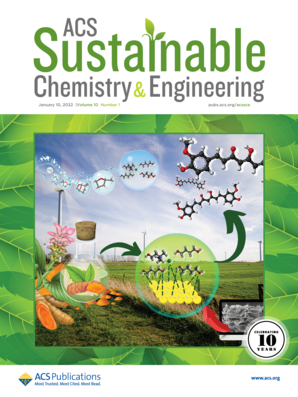用于高岭石微粒疏水团聚的生物启发黄烷表面活性剂
IF 7.1
1区 化学
Q1 CHEMISTRY, MULTIDISCIPLINARY
引用次数: 0
摘要
随着环境问题的增加和目前工业中使用的合成材料的缺点,在矿物加工应用中对更生态友好和更有效的替代品的需求日益增加。为了解决这一问题,通过安装仲烷基胺和叔烷基胺来修饰植物色素黄烷的核心结构,合成了三种生物激发表面活性剂(M8Flav、M12Flav和D8Flav)。研究了这些生物表面活性剂对高岭石(d4,3: 10 μm)微粒疏水团聚的促进作用。通过光谱、显微镜和x射线衍射(XRD)分析,研究了黄酮类化合物与高岭石的关系,包括阐明了高岭石集合体宏观性质变化的潜在相互作用和机制。采用Washburn毛细管上升法对高岭石的表面疏水性进行了评价,发现表面活性剂对高岭石的疏水性有增强作用。采用图像粒度测量技术,在可控剪切速率下进行了实时现场骨料粒度测量,系统评估了表面活性剂用量和烷基链构型对骨料粒度和稳定性的影响。研究了表面活性剂处理的高岭石浆料在静息条件下,上清液的降浊性和重力沉降性。这些发现揭示了黄烷基表面活性剂的适用性,将它们定位为改进粘土分离和脱水过程技术的有价值的工具。本文章由计算机程序翻译,如有差异,请以英文原文为准。

Bioinspired Flavylium Surfactants for Hydrophobic Agglomeration of Fine Kaolinite Particles
With increasing environmental concerns and the drawbacks associated with the synthetic materials currently used in industry, there is a growing demand for more eco-friendly and efficient alternatives in mineral processing applications. To help address this, three bioinspired surfactants (M8Flav, M12Flav, and D8Flav) were synthesized by modifying the core structure of flavylium, a plant-based pigment, by installing secondary and tertiary alkyl amines. Hydrophobic agglomeration of fine kaolinite (D4,3: 10 μm) particles facilitated through the application of these bioinspired surfactants was examined. Spectroscopic, microscopic, and XRD (X-ray diffraction) analyses were performed to interrogate the association of flavylium with kaolinite including the elucidation of potential interactions and mechanisms for the changes in macroscopic properties of the kaolinite aggregates. The surface hydrophobicity of kaolinite was evaluated using the Washburn capillary rise method, with enhanced hydrophobicity observed after treatment with the surfactants. Real-time in situ aggregate size measurements under a controlled shear rate were conducted using an image-derived particle size measuring technique to systematically evaluate the impact of surfactant dosage and alkyl chain configuration on aggregate size and stability. Turbidity reduction of the supernatants and gravitational sedimentation under quiescent conditions of surfactant-treated kaolinite slurries were also examined. These findings reveal the applicability of flavylium-based surfactants, positioning them as valuable tools for improving techniques in clay separation and dewatering processes.
求助全文
通过发布文献求助,成功后即可免费获取论文全文。
去求助
来源期刊

ACS Sustainable Chemistry & Engineering
CHEMISTRY, MULTIDISCIPLINARY-ENGINEERING, CHEMICAL
CiteScore
13.80
自引率
4.80%
发文量
1470
审稿时长
1.7 months
期刊介绍:
ACS Sustainable Chemistry & Engineering is a prestigious weekly peer-reviewed scientific journal published by the American Chemical Society. Dedicated to advancing the principles of green chemistry and green engineering, it covers a wide array of research topics including green chemistry, green engineering, biomass, alternative energy, and life cycle assessment.
The journal welcomes submissions in various formats, including Letters, Articles, Features, and Perspectives (Reviews), that address the challenges of sustainability in the chemical enterprise and contribute to the advancement of sustainable practices. Join us in shaping the future of sustainable chemistry and engineering.
 求助内容:
求助内容: 应助结果提醒方式:
应助结果提醒方式:


